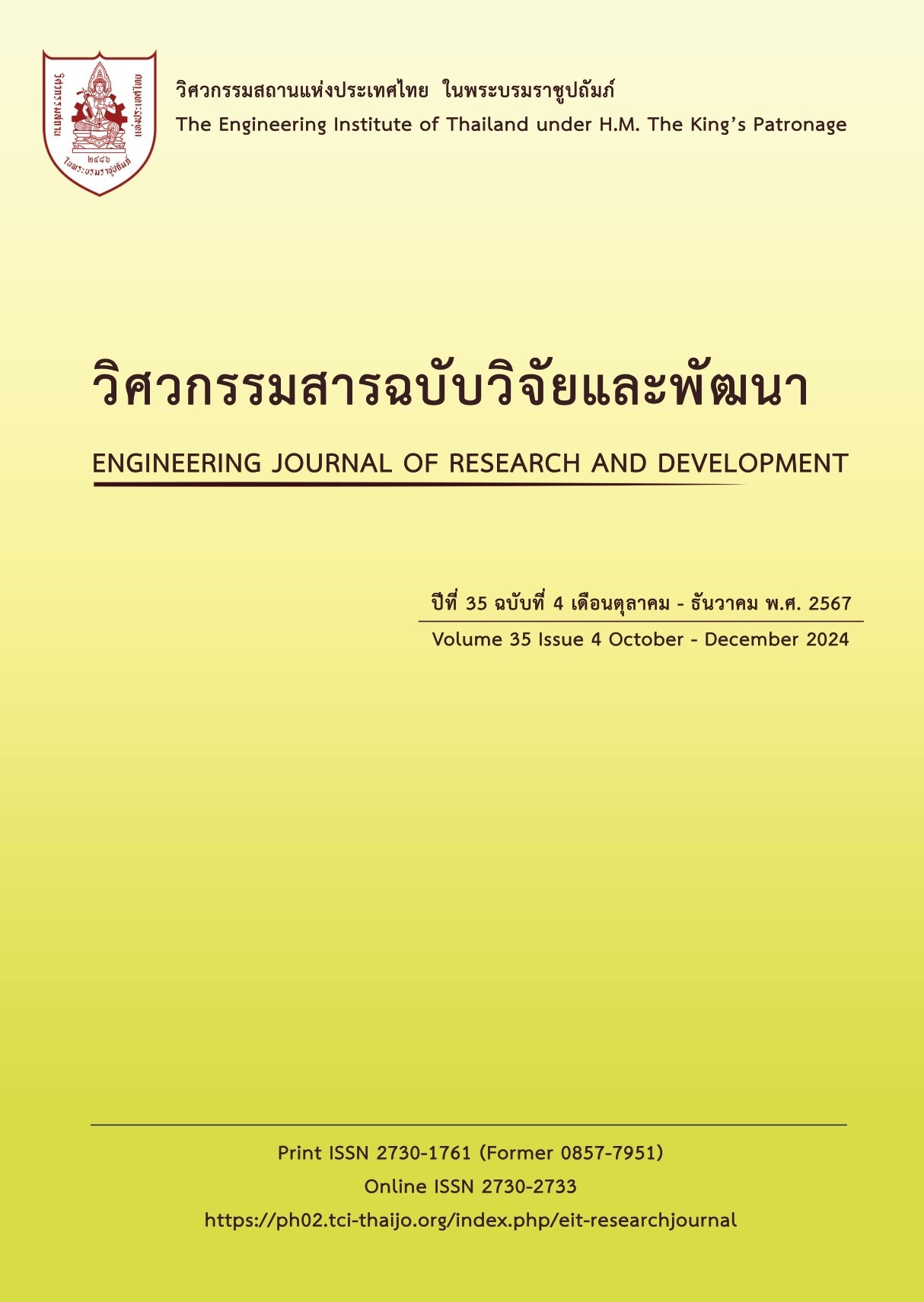OPTIMIZING MAP PROJECTIONS FOR EQUILIBRIUM AND MINIMAL DISTORTION IN PROVINCIAL CONSTRUCTION PROJECTS
Main Article Content
Abstract
The Universal Transverse Mercator (UTM) projection is widely used in design and construction projects in Thailand. However, in some areas, it may introduce linear distortions of up to 965 ppm. Therefore, the linear distortion caused by the UTM projection is considered a significant systematic error. This study investigates the design of Low Distortion Projections (LDP) at the provincial level, including Transverse Mercator (TM), Lambert Conformal Conic Projection (LCC), and Oblique Mercator (OMC). The research highlights the importance of "urban areas," where construction frequently occurs. These areas often have terrain elevations higher or lower than the average topographic surface, necessitating the development of a provincial LDP with a Combined Scale Factor (CSF) between -20 ppm and +20 ppm, covering over 80% of urban areas.Furthermore, an optimal balance for construction project LDPs is sought, with CSF values ranging between -10 ppm and +10 ppm.Using Phayao Province as a case study, specifically the Denchai - Chiang Rai - Chiang Khong railway project, Contract 2 (Ngao - Chiang Rai section), it was found that the Transverse Mercator LDP was the most suitable. This projection resulted in a provincial CSF range of -18 to +17 ppm and a project-specific CSF range of -8 to +8 ppm. Horizontal and vertical distortions were also analyzed using LDP parameters from control points within the project. The results revealed horizontal and vertical deviations ranging from -6 to +6 millimeters, demonstrating that a combined scale factor was unnecessary in practice. Selecting an appropriate LDP can significantly reduce errors in design and construction caused by map distortions. It is anticipated that Low Distortion Projections will play a more prominent role in Thailand's construction industry in the future.
Article Details

This work is licensed under a Creative Commons Attribution-NonCommercial-NoDerivatives 4.0 International License.
The published articles are copyright of the Engineering Journal of Research and Development, The Engineering Institute of Thailand Under H.M. The King's Patronage (EIT).
References
ไพศาล สันติธรรมนนท์, ประจวบ เรียบร้อย, ชาญชัย พัชรอาภา. ผลการศึกษาการฉายแผนที่ WGS-TM ในโครงการรถไฟความเร็วสูงไทย-จีน .
วิศวกรรมสารฉบับวิจัยและพัฒนา, ปีที่ 32 ฉบับที่ 2 พ.ศ.2563. หน้า 11-23.
ไพศาล สันติธรรมนนท์, ประจวบ เรียบร้อย, ชาญชัย พัชรอาภา. การศึกษาศักยภาพการฉายแผนที่ความคลาดเคลื่อนต่ำสำหรับประเทศไทย .
วิศวกรรมสารฉบับวิจัยและพัฒนา, ปีที่ 32 ฉบับที่ 2 พ.ศ.2564. หน้า 39-57.
ไพศาล สันติธรรมนนท์, ถิรวัฒน์ บรรณกุลพิพัฒน์, บดินทร์ จุลนาค. หลักการออกแบบการฉายแผนที่ความคลาดเคลื่อนต่ำสำหรับโครงการ.
วิศวกรรมสารฉบับวิจัยและพัฒนา, ปีที่ 33 ฉบับที่ 4 พ.ศ.2565. หน้า 47-65.
Snyder, J.P. Map Projection: A Working Manual. Professional Paper, 1395, US Government Printing Office: Washington, 1987.
PROJ contributors. PROJ coordinate transformation software library. Open-Source Geospatial Foundation.2024 URL https://proj.org/. DOI: 10.5281/zenodo.5884394
Juliana P. Blackwell: State Plane Coordinate System of 2022 Policy Document, National Geodetic Survey, National Ocean Service, National Oceanic and Atmospheric Administration, 2019
Tozer, B, Sandwell, D. T., Smith, W. H. F., Olson, C., Beale, J. R., & Wessel, P. Global bathymetry and topography at 15 arc sec: SRTM15+. Earth and Space Science, 6, 1847, 2019. DOI: 10.1029/2019EA000658
PAVLIS, N. K. et al. The development and evaluation of the Earth Gravitational Model 2008 (EGM2008). Journal of Geophysical Research, 2012, 117. DOI: 10.1029/2011JB008916
WorldPop (www.worldpop.org - School of Geography and Environmental Science, University of Southampton). 2014. Thailand 100m Population. Alpha version 2010, 2015 and 2020 estimates of numbers of people per pixel (ppp) and people per hectare (pph), with national totals adjusted to match UN population division estimates (http://esa.un.org/wpp/) and remaining unadjusted. DOI: 10.5258/SOTON/WP00267

